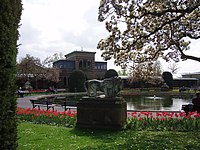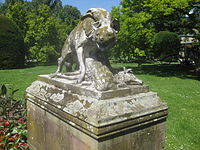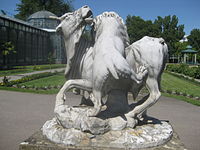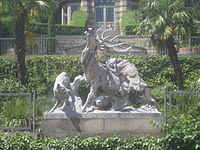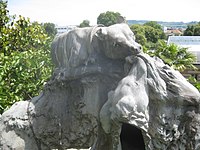Animal sculptures (Wilhelma)
In the Moorish Garden of Wilhelma in Stuttgart, nine animal sculptures made of marble or cast zinc are set up, most of which depict animal fighting scenes. Except for one sculpture , all were created by the Stuttgart sculptor Albert Güldenstein .
overview
All animal sculptures except No. 5 are by the Stuttgart sculptor Albert Güldenstein , No. 5 is by an unknown Italian sculptor.
| No. | Work title | Year of origin | material | Location |
|---|---|---|---|---|
| 0 | Lion defending his cub | 1857 | Carrara marble | (lost) |
| 1 | Two gazelles | 1856/1857 | Carrara marble | at the great basin |
| 2 | Hyena with a stolen lamb | 1857 | Carrara marble | at the great basin |
| 3 | Tiger fighting a snake | 1856 | Carrara marble | at the great basin |
| 4th | Lion striding forward with head bent sideways | 1857 | Carrara marble | at the great basin |
| 5 | Bull attacked by a lion | before 1817 | Carrara marble | in front of the Moorish country house |
| 6th | Panther jumping on the back of a gazelle | 1848 | Carrara marble | in front of the Moorish country house |
| 7th | Deer attacked by three wolves | 1852 | Zinc casting | in the terrace systems |
| 8th | Bear hats | 1853 | Zinc casting | in the terrace systems |
| 9 | Wild boar hat | 1853 | Zinc casting | in the terrace systems |
Location

The six marble sculptures (red 1–6) are in front of the former Moorish ballroom (MF, today aquarium / terrarium) and below the Moorish country house (ML). Groups 1–4 are set up at the Great Basin (GB = water lily pond), groups 5–6 on the terrace directly in front of the main portal of the Moorish country house (ML).
The three zinc sculptures (7–9) crown the retaining walls behind the Moorish country house (ML) and in front of the Belvedere (B). Sculpture 7 crowns the lower retaining wall, groups 8 and 9 flank the upper retaining wall.
The red numbers indicate the animal sculptures
Marble sculptures
1 = two gazelles, 2 = hyena with a stolen lamb, 3 = tiger fighting a snake, 4 = lion striding forward with head bent sideways, 5 = bull attacked by a lion, 6 = panther, jumping on the back of a gazelle
Zinc sculptures
7 = deer attacked by three wolves, 8 = bear hats, 9 = wild boar hats
description
In the years 1848–1857, nine animal sculptures by the Stuttgart sculptor Albert Güldenstein were set up in Wilhelma . They joined animal group 5 (bull attacked by a lion), which was made by an unknown Italian sculptor and had been in Wilhelma since 1846. The seven sculptures 0–6 are made of Carrara marble , the three animal sculptures 7–9 were cast in zinc by the Stuttgart art foundry, Wilhelm Pelargus , based on Güldenstein's models .
Of the original 10 animal sculptures, nine have survived. Group 0 (lion defending its cub) was probably destroyed in World War II. The zinc sculptures 7–9 were damaged during the war. Groups 8–9 (bear and wild boar hats) are so badly damaged that many details can no longer be seen.
The six remaining marble sculptures are all in good condition, but parts that are particularly vulnerable to breakage, such as the tips of the ears, the ends of the horns, the ends of the tails and teeth, are sometimes missing. Incidentally, all marble sculptures are more or less heavily soiled and suffer from green deposits or lichen infestation, the marble is also blackened in places. Even if the damage and soiling have their own morbid appeal, there is always the risk of further deterioration.
The animal sculptures make up no small part of the artistic decoration of the Moorish Garden. Almost all sculptures depict animal hunting and fighting scenes. An exception is sculpture 1 with two fleeing gazelles, whose pursuer is not shown, and sculpture 4, which only shows a striding lion, which, however, with its threatening gesture, is blocking an invisible enemy in check seems to hold.
About the work titles: In the headings the work title from the official documents is given (animal group 0, 7–9), otherwise the title from Büchele's Stuttgart City Guide from 1858.
Marble sculptures
The marble sculptures are made from Carrara marble. They survived the turmoil of the last war well, except for sculpture 0 (lion defending its cub), which has been missing since the war. Most of the sculptures are intact, but suffer from the constant weather and environmental pollution, so that they are partially or heavily soiled and suffer from green deposits or lichen infestation. The sculptures are placed on raised, rectangular sandstone pedestals that are coffered with three or two inlaid red plates on each side.
(0) Lion defending its cub
| Other work titles: Lion defending its cub.
Sculptor: Albert Güldenstein. Carrara marble sculpture, created 1857, probably destroyed in World War II. Original location: in the roundabout at the entrance of the Moorish ballroom. No description of the sculpture has survived. Literature: Büchele 1858 , p. 291, Wais 1954 , p. 58. |
(1) Two gazelles
| Other work titles: Zwei Deer; Two escaping deer.
Sculptor: Albert Güldenstein. Sculpture made of Carrara marble on a raised, rectangular sandstone pedestal, year of origin 1856 (model), 1856/1857 (execution), unmarked, Stuttgart, Wilhelma, front left at the large basin (water lily pond). Conservation condition: good, broken ear and horn tips, middle section of a barrel is missing, dirty, thick green covering. Two frightened gazelles, mother and child, flee into the unknown with their graceful, sweeping legs. The gazelle child looks for help at his mother, who is headlong ahead of him, and listens to the pursuer with wide open, flying ears. Literature: AKL , Büchele 1858 , p. 291, Herzog 1990 , p. 46, John 2000 , p. 82, Wais 1954 , p. 58. |
(2) Hyena with a stolen lamb
| Other work titles: Hyena with a torn ram.
Sculptor: Albert Güldenstein. Sculpture made of Carrara marble on a raised, rectangular sandstone pedestal, year of origin 1856 (model), 1857 (execution), unmarked, Stuttgart, Wilhelma, front right on the large basin (water lily pond). Conservation status: good, the tips of the hyena's ears broken, dirty, thick green cover. A terrifying hyena has brought down a lamb or a ram. This lies, exhausted from the agony and now dead, all fours stretched out, under the mighty dome, which the robber's torso spans over the peaceful sheep, its legs set up like columns and spread out on all sides, always on the go to the prey defend. Its back mane bristling like a dinosaur's comb, its ears pricked up and its jaws wide open, the hyena roars at its invisible food rival in order to chase him away. Literature: AKL , Büchele 1858 , p. 291, Herzog 1990 , p. 46, John 2000 , p. 82, Wais 1954 , p. 58. |
(3) Tiger fighting a snake
| Other work titles: Panther fighting a giant snake.
Sculptor: Albert Güldenstein. Sculpture made of Carrara marble on a raised, rectangular sandstone pedestal, year of origin 1856 (model), 1856 (execution), unmarked, Stuttgart, Wilhelma, rear left at the large basin (water lily pond). Conservation status: good, ear tips missing, heavily soiled. An unequal battle is taking place. A mighty, elegant tiger or panther is walking when he suddenly starts up a snake, almost twice as long as himself (did he unconsciously step on it?), And the snake in desperation wraps around his body and wants him to do so Squeeze life. The panther opens its mouth wide with its terrible fangs and roars in pain and anger. The snake stretches its head up at a safe distance, it seems to trust its strangling power, but perhaps the panther will succeed in tearing off the head of the strange enemy with a last effort. Literature: AKL , Büchele 1858 , p. 291, Herzog 1990 , p. 46, John 2000 , p. 82, Wais 1954 , p. 58. |
(4) Lion striding forward with head bent sideways
| Other work titles: Lion with threatening gesture.
Sculptor: Albert Güldenstein. Sculpture made of Carrara marble on a raised, rectangular sandstone pedestal, year of creation 1856 (model), 1857 (execution), unmarked, Stuttgart, Wilhelma, in the back right at the large basin (water lily pond). Conservation status: good, dirty, marble blackened in places, green pavement. The king of the beasts strides forward, bursting with strength, on his strong paws, dragging his mighty mane on the ground. He turns his head with the characteristic mane of the lion man threateningly towards the viewer, with his jaws open and showing the fatal teeth. He supports his long, majestic tail on the ground as if it were a fifth member. Literature: AKL , Büchele 1858 , p. 291, Herzog 1990 , p. 46, John 2000 , p. 82, Wais 1954 , p. 58. |
(5) Taurus attacked by a lion
| Sculptor: unknown Italian artist.
Sculpture made of Carrara marble on a raised, rectangular sandstone pedestal, year of origin before 1817, King Wilhelm is said to have inherited the sculpture from his father King Friedrich , who died in 1816, unmarked, Stuttgart, Wilhelma, left in front of the Moorish country house. Original location: to the right or left of the Moorish ballroom. Conservation status: slightly damaged, the lion is missing the middle section of the tail, the bull is missing the tail and a horn tip, soiled and covered with greenery. In the front view, you can only see the magnificent mane head of the lion, which attacks a bull and presses it to the ground with its dangerous paws, so that it kneels with its front hooves. The robber bites his victim's back with its sharp teeth and mercilessly digs its extended pointed claws into the flesh of the hopelessly lost. The lion keeps his eyes closed - as if lost in his murderous work. The defenseless bull bends his head back with an effort, as if to see what is happening to him. Literature: Büchele 1858 , p. 291, Herzog 1990 , p. 11, Heß 1847 , p. 293, Wais 1954 , p. 58. |
(6) Panther jumping on the back of a gazelle
| Other work titles: Leopard jumping on a gazelle; Panther tearing a gazelle.
Sculptor: Albert Güldenstein. Carrara marble sculpture on a raised, rectangular sandstone pedestal, year of origin 1848, inscribed: “A. Güldenstein. Rome. 1848. ”, Stuttgart, Wilhelma, right in front of the Moorish country house. Original location: to the right or left of the Moorish ballroom. Conservation status: good, the gazelle is missing an ear and the lion is missing an ear tip, soiled and covered in green. Sitting with legs apart on the back paws, a lioness of impressive and terrifying body bites into a graceful gazelle. With her enormous body weight, she forces the slender animal down on its knees in order to more easily break the helpless and defenseless animal's backbone. The lioness curls her long, snake-like tail like a barrier in front of the gazelle, but the gazelle has no chance of escaping anyway. This was the first group of animals that Güldenstein was allowed to make on behalf of King Wilhelm I. It was supposed to become a "side piece" to No. 5, and in fact the two sculptures with the lion man and lion woman, placed face to face, look like two sides of the same coin. This first order was to be followed by eight more. Literature: AKL , Büchele 1858 , p. 291, Herzog 1990 , p. 12, 93, Heß 1847 , p. 293, Wais 1954 , p. 58. |
Zinc sculptures
For the zinc sculptures 7–9, Güldenstein made the plaster models, which were then cast in zinc by Wilhelm Pelargus in the Stuttgart art ore foundry . For stabilization, the zinc sculptures were given a supporting iron frame inside, which is clearly visible on Sculptures 8 and 9 due to the war damage. The finished sculpture was bronzed, ie it was painted in a bronze color to cover the unattractive zinc gray. All three groups represent a variation on the same theme: an animal is caught and torn down by several pack hunters. The victims are deer, boar and bear, the hunters are wolves and dogs. The three groups are enthroned on the retaining walls of the terrace behind the Moorish country house, with the two dog hunts 8 and 9 (bear and wild boar) adorning the flanks of the retaining wall in front of the Belvedere as counterparts.
The zinc sculptures 7–9 were partly badly damaged during the war. The deer group was patched up in a few places, all groups are missing the original bronzing. The sculptures are placed on low, rectangular sandstone plinths.
(7) Deer attacked by three wolves
| Other work titles: Deer attacked by wolves; Deer attacked by wolves; Wolves attacking a deer; Wolves kill a deer; Deer attacked by wolves; Deer group.
Sculptor: Albert Güldenstein, zinc casting: Wilhelm Pelargus . (Originally bronzed) zinc sculpture on a low, rectangular sandstone plinth, year of origin 1851 (model), 1852 (cast) unmarked, Stuttgart, Wilhelma, on the center of the terrace wall behind the Moorish country house. Conservation condition: bad, damaged in World War II, one wolf is missing the abdomen, another the front body and a leg piece, the third one is missing the tail, partly patched up poorly. A terrible drama takes place on the top of the first terrace wall. A proud twelve-pointed stag is caught on the run by a wild wolf pack. One of the wolves (without a head) rushes sideways, throws himself in front of the stag's right front hoof so that it stumbles, and cuts his fangs into the left front leg. The second wolf turns the corner furiously, he has reached the stag and will jump at his throat. The third of the bloodthirsty beasts (without an abdomen) blasts from behind, it is already clawing the stag in the back, biting into it and will break its spine. The doomed king of the forest shoots his neck wide and sends his plaintive cries for help to heaven, which cannot help him. Literature: AKL , Büchele 1858 , p. 292, John 2000 , p. 85, Kress 1987 , p. 104, NN 1851 , Wais 1954 , p. 58. |
(8) Bear hats
| Sculptor: Albert Güldenstein, zinc casting: Wilhelm Pelargus .
(Originally bronzed) zinc sculpture on a low, rectangular sandstone plinth, (originally a "wolf with dogs" was planned. Year of origin 1853 unmarked, Stuttgart, Wilhelma, left on the terrace wall in front of the Belvedere. Conservation status: poor, badly damaged in the Second World War, the bear and one dog have no abdomen, another the tail. On the left flank of the Belvedere retaining wall is a mighty brown bear that was attacked by a pack of three dogs. One dog, jumping up, bit itself on the bear's throat, another crawls up to the bear with its rear end up and its snout close to the ground. The bear holds the third member of the group with his paws as if in a vice, the dog screeches and screams in pain, but at first there is no thought of escaping. Angry and desperate, the bear raises its head in the air. The battle is not over, who will win? Literature: AKL , Büchele 1858 , p. 292, Herzog 1990 , p. 12, 93, John 2000 , p. 85, Kress 1987 , p. 104, Wais 1954 , p. 58. |
(9) Wild boar hats
| Other work titles: Sauhatz; Pig hunt; Swine chase with three dogs; Boars with dogs; Wild boar with dogs.
Sculptor: Albert Güldenstein, zinc casting: Wilhelm Pelargus . (Originally bronzed) zinc sculpture on a low, rectangular sandstone plinth, unmarked year of origin 1853, Stuttgart, Wilhelma, on the right on the terrace wall in front of the Belvedere. Conservation condition: bad, badly damaged in the Second World War, the boar is missing a rear piece and a leg, a dog is missing its abdomen, the lying dog is missing two legs and a tail piece, of one dog only two paws and the tip of the tail are preserved. On the right flank of the Belvedere retaining wall, a shaggy, wild boar fights for its life against a horde of five bloodthirsty dogs. With one leap, a dog jumped on the boar's back to break its back. Another dog jumps up on him and comes to the aid of the companion, because cracking the boar's back is no picnic. The third dog lies in a leaping position at the boar's feet, he barks at him eye to eye, apparently without being afraid of the big fangs in the boar's wide open mouth. A dog lies behind the boar and stretches all fours in the air. Literature: AKL , Büchele 1858 , p. 292, Herzog 1990 , p. 12, 93, John 2000 , p. 85, Kress 1987 , p. 104, Wais 1954 , p. 58. |
history
In 1846, the historic Wilhelma was inaugurated on the occasion of the wedding of Crown Prince Karl and the Tsar's daughter Olga Nikolajewna . Of the ten later animal sculptures, only sculpture 5 (bull attacked by a lion) was in the Wilhelma. It was the work of an unknown Italian sculptor, which King Wilhelm's father Friedrich had originally set up in front of the New Palace.
Güldenstein's first marble group (1848)
After training as an engraver and chaser, Albert Güldenstein came to Stuttgart in 1843, where he began his training as a sculptor at the art school under Theodor Wagner . In 1847 the King visited Güldenstein in his workshop to see a piece of work he had made for Crown Prince Karl's newly built Villa Berg . He also saw some animal sculptures that Güldenstein had modeled and gave him the task of creating a counterpart to the group of animals in the Wilhelma. While still in Stuttgart, Güldenstein created a model of animal group 6 (panther, jumping on the back of a gazelle), which was applauded by the king. During his stay in Rome 1847–1848, Güldenstein executed the model in Carrara marble and completed the sculpture in 1848.
Zinc sculptures (1851-1853)
Apparently Wilhelm was satisfied with Güldenstein's work. He was commissioned for three more sculptures, groups 7–9, which, however, were not made in marble, but rather cast in zinc by the Stuttgart foundryman Wilhelm Pelargus. The model of the deer group (sculpture 7) was finished in 1851 and cast in 1852. One year later, the other two groups 8–9 (bear and wild boar hats) were also implemented.
The remaining marble sculptures (1856–1857)
After the first marble sculpture in 1848, five more marble sculptures were created by Güldenstein in 1856 and 1857 (sculpture 0–4). The lost sculpture 0 (lion defending its cub) was set up in the roundabout in front of the Moorish Festsaal, flanked by the two lion fighting sculptures 5 and 6. Groups 1–4 were installed at the diagonal corners of the path around the Great Basin (water lily pond) .
Post-war period (from 1945)
After the war, the heavily damaged Moorish ballroom was demolished and the aquarium / terrarium built in its place, which ends with part of the rear facade of the former ballroom. The sculpture 0 (lion defending its cub), which stood in the roundabout in front of the ballroom, was probably destroyed. The two lion fighting sculptures 5–6 were moved in front of the Moorish country house. The remaining marble sculptures 1–6 survived the war well. The zinc sculptures 7–9 were partly badly damaged during the war and have been waiting to be restored since then; however, the disintegration continues.
Güldenstein's animal sculptures (and the sculpture by the unknown Italian sculptor) were the first wild animals in the Wilhelma, which at that time was not a zoo but a royal palace park. Through the development of Wilhelma into a zoological garden, the lifeless animal figures of another time got a variety of lively society and today loosen up the rich botanical-zoological garden.
reception
There are only a few known critical statements about the animal sculptures made by Wilhelma. In 1851, an unknown author mentioned in the Deutsche Kunst-Zeitung "the very famous group of animals" wolves attacking a deer ", the model of which was made in the same year.
In 1854 Güldenstein exhibited together with Wilhelm Pelargus at the First General German Industrial Exhibition in Munich, among other things, a second cast of the deer group, which was intended for the Cologne merchant W. Meurer , and a candelabra. In the report of the “Assessment Commission” it was stated: “As lively as the groups of animals are, and so skilfully put together, the execution must be called a very poor one.” Nevertheless, Güldenstein received an honorable mention “because of the liveliness in his animal sculptures ". Out of 104 exhibitors assessed in the “Plastic Objects” category, 6 received a large commemorative coin, 19 an honorary coin and 36 an honorable mention, ie more than half of the participants were honored.
Karl Büchele wrote in his Stuttgart city guide in 1858 about Güldenstein's animal sculptures that they “emerged from the studio of the sculptor Güldenstein, who is most famous in this genre”. In 1886, an unknown author named Güldenstein's work in the Allgemeine Zeitung des Judentums: “three groups of animals distinguished by great natural truth for the Wilhelma near Stuttgart, (deer attacked by wolves, bear and pig hunting)”.
The animal sculptures have not yet received any art-historical appreciation. It would be interesting to find out whether Güldenstein, like the Württemberg court sculptor Antonio Isopi (1758–1833), worked from living models or whether he used sculptures and drawings by other artists as models. An iconographic comparison would also be desirable. For a zoologist, it could be an appealing task to check the animal sculptures for their lifelike quality and the realism of the fighting scenes and animal behavior.
Even if Wilhelma's animal sculptures have not met with a great response in the art world, they have been admired for decades by thousands and thousands of animal lovers who visit Wilhelma.
Galleries
Historical views
Modern views
Individual groups
literature
- Stuttgart, Main State Archives
- E 14 Bü 176, 1851–1855, 20
- E 14 Bü 191, 1851–1888, 6
- E 14 Bü 202.
- Karl Büchele: Stuttgart and its surroundings for locals and foreigners , Stuttgart 1858, pp. 291-292 [1] .
- Herbert Fecker: Stuttgart, the palaces and their gardens. The development of palaces and gardens from the count's residence to the international horticultural exhibition , Stuttgart 1992, pp. 99, 101 (1 illustration).
- G .: Stuttgart, Aug. 2, In: Deutsches Kunstblatt 7.1856, p. 291.
- Karin Herczog; Micha Sonnenfrüh: Of bears and deer of a completely different kind. Animal sculptures in the Wilhelma. In: Wilhelma-Magazin 2014, Issue 1, pp. 20–21.
- Friedrich Benedict Wilhelm von Hermann: Report of the assessment commission at the general German industrial exhibition in Munich in 1854 , Munich 1855, XII. Group: Achievements of the fine arts, p. 12 [2] , p. 43 [3] , after page 45 [4] .
- Rainer Herzog: Wilhelma Stuttgart. Documentation of the historical and design development of the Wilhelma gardens , Stuttgart 1990, pp. 11, 12, 46, 93.
- Mendel Hess: Various things from Württemberg . In: The Israelite of the Nineteenth Century. A weekly for the knowledge and reform of Israelite life No. 37 of September 12, 1847, p. 293 [5] .
- Timo John: The royal gardens of the 19th century in Stuttgart , Worms 2000, pp. 82, 84, 85 (1 illustration).
- Wolfgang W. Kress: From tin to ore - The Stuttgart art ore foundry family Pelargus. In: Schwäbische Heimat 38.1987, p. 104.
- Gerd Leibrock A sculptor from Sontheim. Albert Güldenstein (1822-1891). In: Christian Schrenk (editor); Annette Geisler (editor): Heilbronner Köpfe VII. Life pictures from four centuries. Heilbronn 2014, pages 91–110.
- Christian Friedrich von Leins: The court camps and country seats of the Württemberg regent house. Festschrift to celebrate the 25th anniversary of His Majesty's government, King Karl von Württemberg , Stuttgart [approx. 1889], pp. 80, 83 (2 illustrations).
- Wilbert Neugebauer: Art in small doses. In: Wilbert Neugebauer: The Wilhelma, a paradise in the city , Stuttgart 1993, pp. 78–79 (5 illustrations).
- NN: German Art Newspaper. Monthly for the fine arts and contemporary artistic life 1.1851, p. 24 [6] .
- NN: A Jewish sculptor. In: Allgemeine Zeitung des Judentums of March 16, 1886 [7] .
- Patricia Peschel: Güldenstein, Albert . In: General Artist Lexicon . The visual artists of all times and peoples (AKL). Volume 64, Saur, Munich a. a. 2009, ISBN 978-3-598-23031-8 , p. 359.
- Friedrich von Schmidt: King Wilhelm von Württemberg in his rural occupations , Stuttgart 1865, after page 28, p. 30 (2 illustrations).
- Elke von Schulz: The Wilhelma in Stuttgart. An example of orientalizing architecture in the 19th century and its architect Karl Ludwig Zanth , Tübingen 1976, p. 80.
- Gustav Wais: Stuttgarts Kunst- und Kulturdenkmale , Stuttgart [1954], pp. 57–58.
Individual evidence
- ↑ E 14 Bü 202 and Büchele 1858 , pp. 291–292.
- ↑ Wais 1954 , p. 58.
- ↑ John 2000 , p. 82.
- ↑ Wais 1954 , p. 58.
- ↑ Wais 1954 , p. 58.
- ↑ Wais 1954 , p. 58.
- ↑ According to Heß 1847 , p. 293.
- ↑ NN 1851 .
- ↑ Kress 1987 , p. 104.
- ↑ E 200 Bü 202 , 1851 & 1852, 3).
- ↑ Kress 1987 , p. 104.
- ↑ Kress 1987 , p. 104.
- ↑ Heß 1847 , p. 293, Wais 1954 , p. 58.
- ↑ Heß 1847 , p. 293.
- ↑ NN 1851 .
- ↑ E 14 Bü 202 , 1853 & 1854, No. 35 and 47, Kress 1987 , p. 104.
- ↑ Hermann 1855 , pp. 12 and 43.
- ↑ Hermann 1855 , after page 45
- ↑ Büchele 1858 , p. 291.
- ↑ NN 1886 .
Remarks
- ↑ Number in the location map .
- ↑ The models of Sculpture 1–4 were ready by the end of July 1856 at the latest ( Kunstblatt 1856 ).
- ↑ The models of Sculpture 1–4 were ready by the end of July 1856 at the latest ( Kunstblatt 1856 ).
- ↑ The models of Sculpture 1–4 were ready by the end of July 1856 at the latest ( Kunstblatt 1856 ).
- ↑ The models of Sculpture 1–4 were ready by the end of July 1856 at the latest ( Kunstblatt 1856 ).
- ↑ Isopi was famous as an ornamentist and animal sculptor. In Ludwigsburg, he ran a self-financed private zoo for the purpose of his animal studies. Güldenstein had the opportunity to study lions, bears, leopards, hyenas and other animals in the private zoo of the Stuttgart innkeeper Affenwerner .
Web link
Coordinates: 48 ° 48 ′ 23.08 " N , 9 ° 12 ′ 21.24" E



















